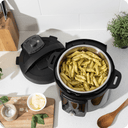Pressure cooking is a method of cooking food in a sealed pot or vessel that uses steam and high pressure to cook food quickly. The sealed environment traps steam produced from the liquid in the pot, which raises the internal pressure. This increase in pressure also raises the boiling point of the liquid, allowing the food to cook faster than it would through traditional cooking methods.
Why Pressure Cookers Are Great
Time Efficiency: Pressure cookers significantly reduce cooking times. The high-pressure environment allows food to cook much faster than with traditional methods, which is especially beneficial for dishes that usually require long cooking periods, like stews, braised meats, and legumes.
Energy Efficiency: Because pressure cookers cook food faster, they use less energy. This makes them an environmentally friendly choice, helping to conserve energy and reduce cooking costs.
Key Phrases To Know
When using a new appliance, there may be terms and phrases that you need to learn. Here are a few examples of pressure vessel vocabulary to learn.
Natural Release vs. Quick Release: These refer to methods of releasing the pressure after cooking:
- Natural Release: This method involves allowing the pressure to dissipate naturally over time, which is often recommended for soups, stews, and other foods that need additional time to settle.
- Quick Release: This involves manually opening the pressure valve to release the steam quickly, which is useful for foods that can easily be overcooked.
Tips For Successful Pressure Cooking
- Use the Right Amount of Liquid: Always ensure there’s enough liquid in the pot to generate steam and build up pressure.
- Do Not Overfill: Never fill a pressure cooker beyond two-thirds of its capacity. For foods that expand during cooking, like rice or legumes, avoid filling the pot beyond half its capacity. This prevents food from blocking the pressure release valve or vent, which could be dangerous.
- Cut Ingredients Uniformly: To ensure even cooking, cut ingredients into uniform sizes. This is particularly important for mixed dishes or stews, where varied cooking times might lead to undercooked or overcooked elements.
- Use the Sauté Function: For multi-cookers with a sauté function, use it to brown meats or sauté vegetables before pressurising. This can add depth of flavour to the dish and reduce the need for extra pans, making for a quicker cleanup.

Choosing The Right Ingredients For Pressure Cooking
Tough cuts of meat like beef brisket and pork shoulder cook quickly and tenderly, making them suitable for stews and curries. Dried legumes such as beans and chickpeas, which typically require long cooking times, are ready in a fraction of the time, as are grains like rice and barley. Vegetables, particularly root vegetables like potatoes and carrots, cook evenly. Pressure cookers can also produce desserts like cheesecakes and puddings, while poultry dishes like chicken and turkey cook efficiently and retain moisture.
Cleaning and Maintenance of Pressure Cookers
- Unplug and Cool Down: If using an electric cooker, unplug it and allow it to cool down.
- Disassemble: Remove the lid and other removable components, such as the sealing ring and pressure release valve.
- Wash Thoroughly: Clean the inner pot, lid, and components with warm, soapy water, using a soft sponge or brush for thorough cleaning.
- Dry Completely: Dry all parts thoroughly with a clean cloth or let them air dry.
- Reassemble: Put the pressure cooker back together, ensuring each component is securely in place.
- Regular Maintenance: Inspect the cooker regularly for wear or damage, particularly on key parts, and replace them as needed.
Pressure Cooker Recipes
Visit our dedicated recipe page. Here, you can explore lots of great meals which are made using a Pressure Cooker. The following are suggestions for meals which work particularly well when cooked in a pressure cooker:
- Stews and Soups: The high pressure helps tenderise tough cuts of meat quickly, while also infusing flavours deeply.
- Beans and Legumes: Beans that usually need overnight soaking and long-simmering can be cooked in a fraction of the time.
- Tough Cuts of Meat: Dishes like brisket or pork shoulder become tender more quickly.
- Risottos and Grains: Achieve creamy risottos and perfectly cooked grains without constant stirring.
- Steamed Vegetables and Seafood: Vegetables retain more nutrients and seafood cooks rapidly, preserving its delicate texture.

